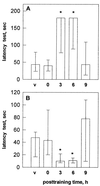Involvement of hippocampal cAMP/cAMP-dependent protein kinase signaling pathways in a late memory consolidation phase of aversively motivated learning in rats
- PMID: 9192688
- PMCID: PMC21281
- DOI: 10.1073/pnas.94.13.7041
Involvement of hippocampal cAMP/cAMP-dependent protein kinase signaling pathways in a late memory consolidation phase of aversively motivated learning in rats
Abstract
cAMP/cAMP-dependent protein kinase (PKA) signaling pathway has been recently proposed to participate in both the late phase of long term potentiation in the hippocampus and in the late, protein synthesis-dependent phase of memory formation. Here we report that a late memory consolidation phase of an inhibitory avoidance learning is regulated by an hippocampal cAMP signaling pathway that is activated, at least in part, by D1/D5 receptors. Bilateral infusion of SKF 38393 (7.5 microg/side), a D1/D5 receptor agonist, into the CA1 region of the dorsal hippocampus, enhanced retention of a step-down inhibitory avoidance when given 3 or 6 h, but not immediately (0 h) or 9 h, after training. In contrast, full retrograde amnesia was obtained when SCH 23390 (0.5 microg/side), a D1/D5 receptor antagonist, was infused into the hippocampus 3 or 6 h after training. Intrahippocampal infusion of 8Br-cAMP (1.25 microg/side), or forskolin (0.5 microg/side), an activator of adenylyl cyclase, enhanced memory when given 3 or 6 h after training. KT5720 (0.5 microg/side), a specific inhibitor of PKA, hindered memory consolidation when given immediately or 3 or 6 h posttraining. Rats submitted to the avoidance task showed learning-specific increases in hippocampal 3H-SCH 23390 binding and in the endogenous levels of cAMP 3 and 6 h after training. In addition, PKA activity and P-CREB (phosphorylated form of cAMP responsive element binding protein) immunoreactivity increased in the hippocampus immediately and 3 and 6 h after training. Together, these findings suggest that the late phase of memory consolidation of an inhibitory avoidance is modulated cAMP/PKA signaling pathways in the hippocampus.
Figures







References
-
- McGaugh J L. Science. 1966;153:1351–1358. - PubMed
-
- Mc Gaugh J L. In: Perspectives of Memory Research. Solomon P R, Goethals G R, Kelley C M, Stephens B R, editors. New York: Springer; 1988. pp. 33–66.
-
- Izquierdo I. Behav Neural Biol. 1989;59:171–202. - PubMed
-
- Davis H P, Squire L R. Psychol Bull. 1984;96:518–559. - PubMed
-
- Castellucci V, Blumenfeld H, Goelet P, Kandel E R. J Neurobiol. 1989;20:1–9. - PubMed
Publication types
MeSH terms
Substances
LinkOut - more resources
Full Text Sources
Other Literature Sources
Medical
Miscellaneous

